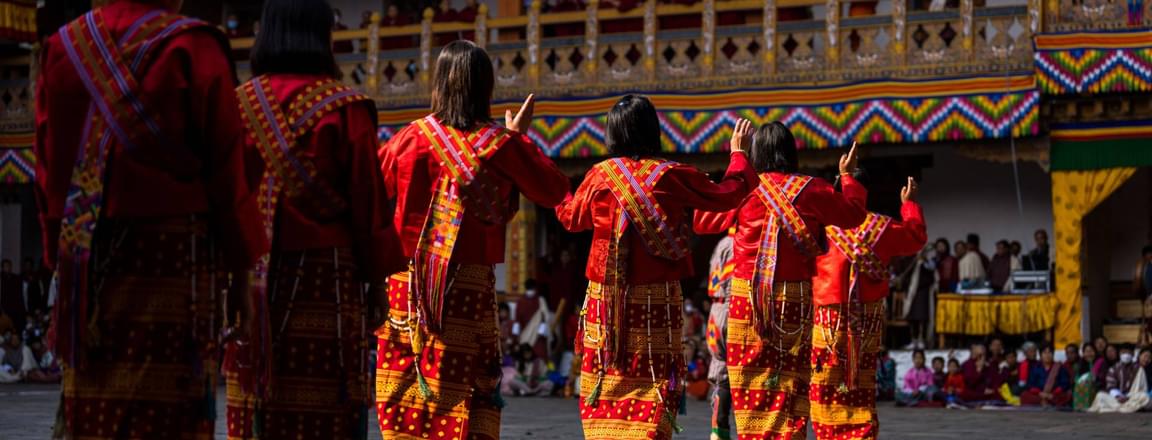
Things to Do in Bhutan

Hidden in the Eastern Himalayas, Bhutan is a country of centuries-old monasteries, Himalayan peaks and profound spirituality. Also known as the "Land of the Thunder Dragon," Bhutan is the only country where tradition overpowers modernity and Gross National Happiness takes precedence over GDP. With its spectacular scenery, vibrant Buddhist culture, and hospitable people, Bhutan provides a rich and spine-tingling travel experience. Whether meditating on a cliffside monastery, trekking through untouched valleys, or relaxing in a traditional hot stone bath, there are a lot of things to do in Bhutan for an experience unlike any other.
Historical and Cultural Attractions
Bhutan's cultural topography is characterised by its strong Buddhist heritage, expressed in the dzongs, temples and yearly religious festivals that colour the country's calendar. The most iconic activity in Bhutan is a visit to Paro Taktsang, or Tiger's Nest Monastery, which sits on the edge of a cliff 3,000 feet above the valley of Paro and is both a physical and spiritual experience, reached through a scenic but difficult trek. In Thimphu, the capital city of Bali, visit the majestic Tashichho Dzong, a grand fortress housing the King's office and the central monastic authority. Located near this is the gigantic Buddha Dordenma Statue, which stands atop a hill with panoramic views of the Thimphu Valley while representing peace and prosperity. In Punakha, the Punakha Dzong, usually considered Bhutan's most stunning dzong, lies at the confluence of the Pho Chhu and Mo Chhu rivers. This ancient place was the old capital and still plays a vital role as a centre of Bhutanese spirituality. For those who want to engage in cultural immersion, make sure to visit one of the many Tsechus, vibrant religious festivals replete with masked dances and rituals for an unforgettable means of access to Bhutanese tradition.
Nature and Adventure Tourism
Bhutan's pristine natural beauty provides a haven for the great outdoors as well as nature and adventure lovers. With more than 70% of its terrain blanketed with forests and large portions of the nation under national park protection, Bhutan is a paradise for ecotourism and adventure travel. One of the best things to do in Bhutan is to go trekking, which is one of the most sought-after activities, ranging from short walks around villages to long, high-altitude expeditions. The Druk Path Trek linking Paro and Thimphu is best for beginners, while the Snowman Trek is rated as one of the toughest in the world, covering isolated mountain passes and high-altitude villages.
Nature enthusiasts can visit Phobjikha Valley, a glacial valley famed for its tranquil views and for its winter habitat of the endangered black-necked cranes. Bumthang Valley, the spiritual heartland of Bhutan, boasts scenic trails, holy temples and moments of peace in pine forests and tranquil farmlands. Adventure enthusiasts can indulge in rafting on the Mo Chhu and Pho Chhu rivers around Punakha or challenge themselves with mountain biking on the hilly trails of Paro and Thimphu.
Spirit and Wellness Experiences
Bhutan's rich spiritual atmosphere is a perfect place to find inner peace and tranquillity. Tourists are invited to participate in meditation classes at monasteries or take part in retreats led by Buddhist monks. One of the most soothing and ancient wellness treatments in Bhutan is the hot stone bath. River stones heated over a fire are put into wooden tubs of medicinal herbs, said to cure muscle pains and circulation problems. The treatment is offered by most local homestays and hotels as part of their service. For those who are interested in astro-spirituality, a visit to a Bhutanese astrologer is an intriguing experience.
Culinary Adventures and Local Flavors
Bhutanese food is an incredible culinary delight as it is high in flavours, distinctive in nature, and often spicy because it liberally employs the use of chilli peppers. The country's national dish, Ema Datshi, is a spicy stew consisting of chillies and local cheese, typically served with red rice. It is a staple food as well as a cultural icon. In Thimphu and Paro, there are an increasing number of cafes and restaurants that offer Bhutanese and foreign cuisine. Hoentay, Phaksha Paa, and Suja are some other foods to try on your gastronomic tour. Sampling Bhutanese cuisine at local markets, like the weekend market in Thimphu, is also a great way to indulge in the authentic culinary delights of the place. These vibrant markets are often buzzing with seasonal produce, homemade cheese, dried fish and numerous grains and spices.
Traditional Crafts and Shopping
Bhutan is famous for its beautiful handicrafts, most of which are created according to age-old techniques handed down from generation to generation. From wood carvings and hand-woven fabrics to Thangkas and handmade paper, all products are manifestations of the essence of Bhutanese craftsmanship. In Thimphu, the National Institute for Zorig Chusum demonstrates Bhutan's 13 traditional arts and crafts. You can observe students making exquisite pieces and buy souvenirs that help keep local heritage alive. Popular shopping destinations are Norzin Lam in Thimphu and Paro handicraft shops, where you can shop for traditional attire such as ghos and kiras, prayer flags, and handmade jewellery.
Festivals and Celebrations
Bhutan’s calendar is dotted with vibrant festivals that offer a deep dive into its spiritual and communal life. Among the most famous is the Paro Tsechu, held in spring, where monks and laypeople perform mask dances to invoke deities and drive away evil spirits. It also calls for families to dress in their finest traditional attire and gather in celebration. The Thimphu Tsechu, organised in the capital city, is another lavish affair with locals and visitors flocking to attend. Village celebrations like Ura Yakchoe or the Haa Summer Festival provide closer interactions, where tourists get to see Bhutanese culture in its truest form.
Update your location?



